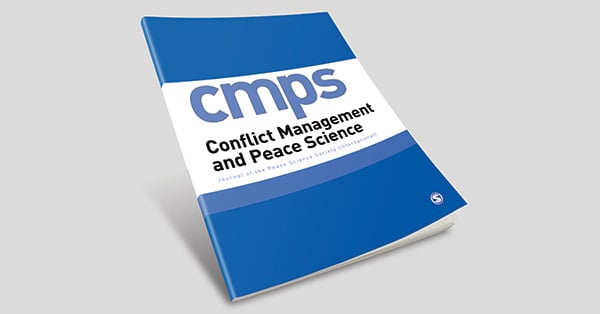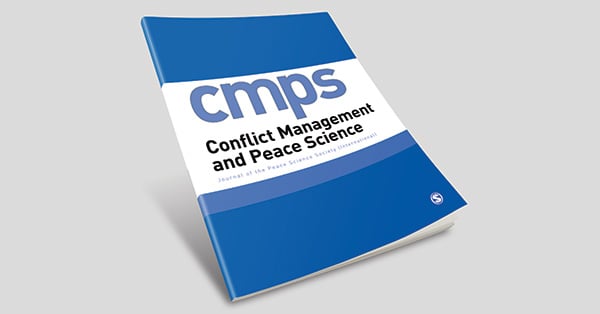
Conflict Management & Peace Science
@cmpseditors
Followers
2K
Following
92
Media
38
Statuses
366
Official Account for Conflict Management and Peace Science, the journal of the Peace Science Society (International) and “a journal that won’t kill your buzz”
@POLISatLeeds
Joined November 2019
CMPS Volume 42 Issue 4 is here. The July issue features five articles on rebel militarisation, UN voting preferences, the media’s impact on postwar attitudes, territorial claims and conflict escalation, and border walls and terrorism.
1
1
7
While this plot shows some ups and downs, the line of best fit suggests a general upward trend in transnationally co-authored papers. This reflects a growing international community and the value of diverse perspectives in our field. #AcademicPublishing #GlobalResearch
0
0
1
Find the whole issue below. We’ll be back with our next issue in September - until then, we hope everyone has a wonderful summer! #Peace #Research #PoliticalScience #IR #Conflict.
journals.sagepub.com
Table of contents for Conflict Management and Peace Science, 42, 4
0
0
0
Finally, @drewrosenberg_ & Nazli Avdan assess whether #Border walls stop transnational #Terrorism. Using network analysis of 63 extremist groups, they find walls can inhibit violence but effects vary by group, challenging walls as a catch-all solution.
journals.sagepub.com
Do border walls inhibit the spread of transnational terrorism? Previous research has primarily measured the volume of terrorism without explicitly modeling its ...
1
0
1
Fourth, Tsukasa Watanabe & Andrew J Enterline @UNT_PSCI examine when territorial claims lead to #War. Using data on 209 claims in Asia and Oceania, they find those tied to incursions, loss, or independence are the most likely to escalate hostilities.
journals.sagepub.com
Under what conditions do territorial claims originate and how do such processes affect military hostility thereafter? We theorize about the impact of four claim...
1
2
3
Third, Carey, Gläßel & Paula ask if media shapes #Postwar attitudes long-term. Studying anti-government broadcasts in #Nepal, they find those exposed were less optimistic about peace, police, and civic activism up to 3 years after the station shut down.
journals.sagepub.com
Can media have a lasting impact on attitudes in postwar countries? A lingering impact of media could substantially shape peace and security in postwar societies...
1
0
0
Second, @courtenaymonroe, Nathan W Monroe & @ShengkuoHu question how #UNGA votes reveal state preferences. They find procedural context matters, with committee amendment votes yielding clearer insights, especially for states away from the policy centre.
journals.sagepub.com
Ideal point estimates, used as measures of state foreign policy preference, are typically constructed from country votes cast on resolutions in the plenary of t...
1
2
3
First, Pamp, Thurner, Binder & Mehltretter @TU_Muenchen ask if more weapons in #Rebel hands escalate #CivilWar violence. Using data on 270 groups, they find better-armed rebels only fight higher-intensity conflicts if they receive no external support.
journals.sagepub.com
Do more weapons in the hands of rebel groups escalate civil wars? We address this question using a recently published dataset on the armaments of 270 non-state ...
1
0
0
RT @DimitarGueorg1: Happy to share a recent paper on the Hong Kong protests, co-authored with the always-excellent @DongshuLiu and publishe….
journals.sagepub.com
Research on social movements suggests that when protesters use violence, public opinion often turns against them, unless the observers already view the proteste...
0
4
0
This not only reflects the importance of teamwork in advancing research, but also the potential for broader perspectives and methodologies. Stay tuned for our next update, which will examine a rising trend in transnationally co-authored papers. #Diversity #Peace #Publishing.
0
0
1
Follow this page for future updates as we shift focus from geographic diversity to other statistics related to published articles at CMPS. #Diversity #Peace #Publishing #ConflictStudies #InclusiveResearch.
0
0
0
Check out the whole issue here, and stay tuned for our next issue in July! In the meantime, follow for more insights from our ongoing series on CMPS submission and acceptance data.
journals.sagepub.com
Table of contents for Conflict Management and Peace Science, 42, 4
0
0
0
Finally, in this issue’s data feature, Jiakun Jack Zhang & Spencer Shanks introduce the China TIES dataset, capturing 135 cases of #China as sender and 88 as target of economic #Sanctions from 1949-2020.
journals.sagepub.com
Research on China's use of economic sanctions has proliferated in recent decades, yet coverage of Chinese sanctions in existing sanctions datasets is both ...
1
0
2
Fifth, @harrietgoers, @laiabalcells & Kathleen Gallagher Cunningham show how internal competition drives self-rule movements to pursue #Referendums, often as a strategy to claim or maintain leadership.
journals.sagepub.com
From Catalonia to Kurdistan to Scotland, referendums have increasingly become popular strategies of self-rule movements. Despite this, many referendums are cons...
1
2
1
Fourth, @SamRBell and @kitagawarisa ask whether #CivilSociety actors can secure protections for themselves during peace #Negotiations, finding that participation boosts the chance of securing post-conflict rights.
journals.sagepub.com
Civil society inclusion in peace processes has many positive externalities, but does inclusion lead to improved rights for civil society actors themselves? We t...
1
2
1






